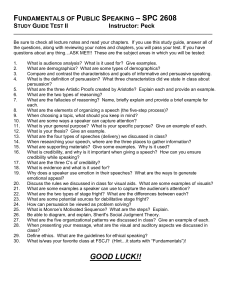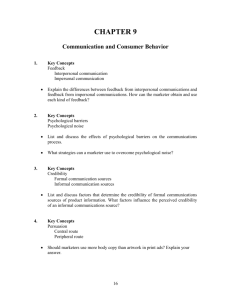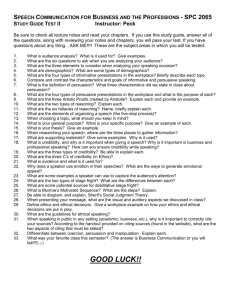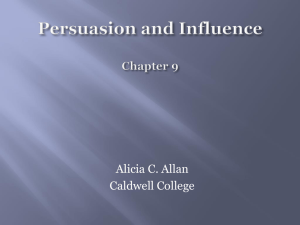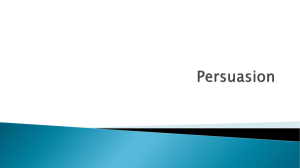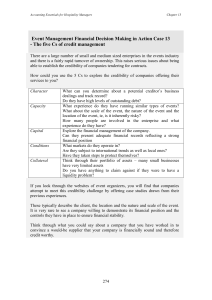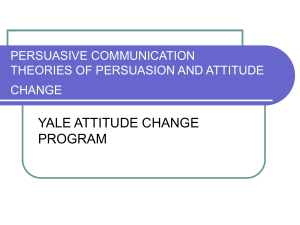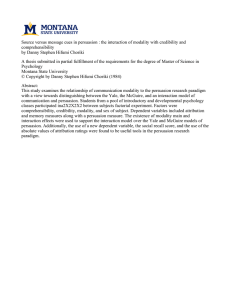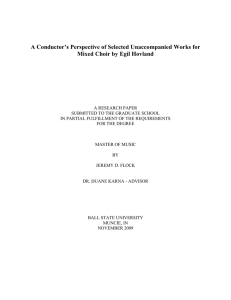Persuasion
advertisement
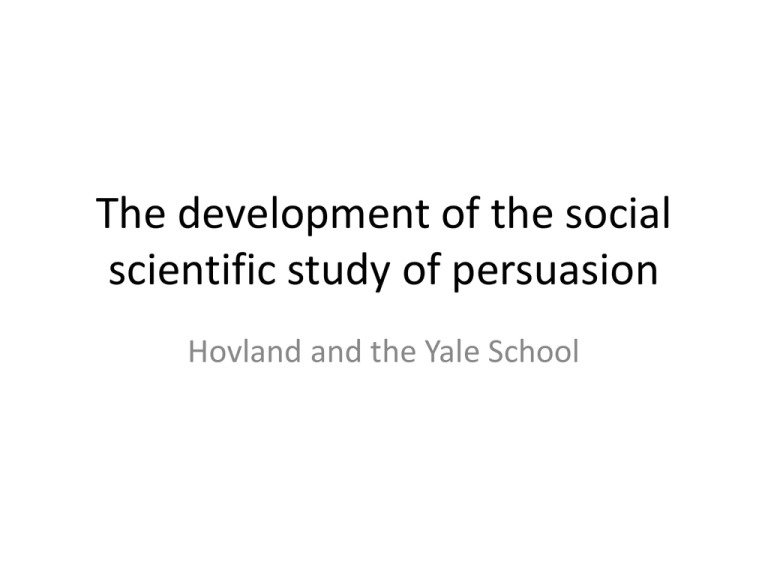
The development of the social scientific study of persuasion Hovland and the Yale School Administrative research • Lazarsfeld distinguished between critical and administrative research by noting that administrative research: • Is carried out in the interest of powerful organizations or government • Takes the existing media system for granted • Aims to adjust the behavior of the audience to the interests of the study Persuasion • Persuasion studies are really propaganda research that tends to take an effects approach – Persuasion really could be considered propaganda – Varies from single exposure individual effects studies to time-based campaign studies of population change The paradigm according to Lasswell: • • • • • Who? Says What? To Whom? In Which Channel? With What Effect? Development of persuasion studies • Classic work of Hovland Experiments on Mass Communication (1949) Communication and Persuasion (1953) Yale School of communication research “Search for the magic keys” WWII American Soldier studies • Part of a large-scale social science investigation of American soldiers recruited or drafted for service in WWII • This part especially interested in the effects of films developed to prepare soldiers for military duty – Why We Fight • Directed by Frank Capra – Documentary explanation of the buildup to, and early years of the war Goals of Why We Fight • Series: Prelude to War, The Nazis Strike, Divide and Conquer, The Battle of Britain Films were intended to foster: • A firm belief in the right of the cause for which we fight • A realization that we are up against a tough job • A determined confidence in our own ability and the abilities of our comrades and leaders to do the job that must be done • A feeling of confidence, insofar as possible under the circumstance, in the integrity and fighting ability of our Allies • A resentment, based on knowledge of the facts, against our enemies who have made it necessary to fight • A belief that through military victory, the political achievement of a better world order is possible Battle of Britain • Men in two camps--some exposed to film, some not – 2100 in one camp (before/after control group) – 900 in another camp (before/after control group) – 1200 (after-only control group) – Sampling by company units • Units matched on several demographic variables Battle of Britain • Before and after questionnaires slightly different – Tried to distract men from wondering why answering twice by writing “revised” on questionnaire • One week between exposure and after measure • Anonymity assured Results • Significant impact on factual knowledge • Ex. Why weren’t the Germans “successful at bombing British planes on the ground”? • Ans. “because the British kept their planes scattered at the edge of the field” • Experimental group: 78% correct • Control group: 21% correct Results • Opinions and interpretations – Effects not as great – “the heavy bombing attacks on Britain were an attempt by the Nazis to . . .” – Answer: “invade and conquer England” • Experimental group: 58% • Control group: 43% Results • Effect on general attitudes was slight • “Do you feel that the British are doing all they can to help win the war?” – Experimental group 7% greater than control – In many such cases, 2-3% positive difference was found • Not much evidence of positive effect Results • Strengthening the overall morale and motivation of viewers • Ineffective – Question concerning whether trainees would prefer military duty in the U.S. or overseas – Experimental 41% – Control 38% Results • Unconditional surrender by Nazis is important war aim – Experimental group 62% – Control group 60% Results • 9 weeks after exposure – Factual material forgotten • Retained only about 50% of factual items that 1-week groups remembered – On 1/3 of opinion issues, long-term group showed less change – However, on more than half of the fifteen issues under study, the long term group showed greater change than the short-term group • “Sleeper effect” One-sided v. two-sided argument • Radio presentation saying war would be lengthy • Presented either as one-sided argument or with additional 4 minutes discussing view that it would be short • Before/after with control group Results • One-sided argument more effective with soldiers who: – Initially supportive of the idea that it would be a lengthy war – Had not completed high school • Two-sided arguments more effective with those who initially felt the war would be short and/or had a high school degree or greater education Results: Learning from films 60 50 40 30 Test Score 20 10 0 Grade School High School College Hovland and the Yale School • Set up Yale school research on persuasion • Study the effect of: – Source characteristics – Message characteristics – Order of presentation – Psychological characteristics of audience Source characteristics • Credibility – Topic: Atomic submarines • Sources: J. Robert Oppenheimer/Pravda – Topic: Future of Movie Theaters • Sources: Fortune magazine/A woman movie gossip columnist – Greater persuasion with more credible source • However, after 4 weeks difference had disappeared • Source: the most famous studies of source effects on attitude change concerned the variable of credibility (Hovland and Weiss). The components of credibility that were emphasized are Expertise and Trustworthiness. • • • • • • • • • • • • • • • • • • • • • • • • • • • a. Should antihistamine drugs continue to be sold without a prescription? b. Can a practicable atomic-powered submarine be built at the present time (1950)? c. Is the steel industry to blame for the current shortage of steel? d. As a result of TV, will there be a decrease in the number of movie theaters in operation by 1955? Sources: High Credibility Low Credibility a. New England Journal of A mass circulation Biology and Medicine monthly pictorial magazine b. Robert J. Oppenheimer Pravda c. Bulletin of National A widely syndicated, Resources Planning Board anti-labor, anti-New Deal, "rightist" newspaper columnist d. ∆—Ô—Ú—Ù—ı—ӗ— magazine An extensively syndicated, woman movie-gossip columnist • • • • • • • • • • • • • • Results: Net Change (% of respondents moving in the direction of the communication minus The % moving in opposite direction) Trustworthy Sources Untrustworthy Sources a. 25.5 11.1 b. 36.0 0.6 c. 18.2 7.4 d. 12.9 17.2 • A communicator's trustworthiness (and effectiveness) can be increased if he or she does not seem to be trying to influence our opinion. – When students thought graduate students were unaware of their presence in an adjoining room, and so would not try to influence them, the conversation "overheard" caused them to change their opinions more than if they thought the graduate students were aware of them. (Walster and Festinger) – Joe (“The Shoulder”) Napolitano • (Aronson) • At least where trivial opinions and behaviors are concerned, if we like and can identify with a person, his or her opinions and behaviors will be more influential upon our own than their content would ordinarily warrant. • Zimbardo, Ebbesen and Maslach list the following as variables affecting communicator credibility: • Power • Competence • Trustworthiness • Good will • Idealism • Similarity (with audience) • Dynamism Content • Fear appeals – Greater fear, greater effect on interest, tension – Lesser fear, greater effect on intension to change behavior – Thought to invoke some sort of interference • Drawing an explicit conclusion – Significantly greater effect if communicator drew an explicit conclusion • On non-involving issues, with positively perceived communicators, amount of opinion change will increase with amount of change advocated. • On involving issues, where there is some ambiguity on communicator credibility change will be greatest for advocacy at moderate distance from own position, and least for same or very different positions. • Aronson's points on message content are: • 1. Some evidence favors appeals which are primarily • emotional over primarily logical. • 2. The more fear-arousing the appeal, the more effective it is. • a. The higher the self-esteem of the audience member, • the more likely he is to be moved by high degrees • of fear arousal. People with low opinions of • themselves were the least likely to take immediate • action, but after a delay, they behaved very much • like the subjects with high self-esteem. • Fear-arousing messages containing specific instructions about how, when and where to take action are much more effective than recommendations that do not include such instructions. • Order of Presentation--Primacy effect is greatest if very little time elapses between the first and second arguments. The first communication produces maximum interference with the learning of the second. • Recency effects will prevail when the audience must make up its mind immediately after hearing the second communication. Message presentation • One-sided and two-sided presentations that USSR would not soon be able to develop a nuclear bomb were equally effective • However, when exposed to opposing view, those that had earlier been presented with two-sided version retained new opinion more than one-sided audience Audience factors • Scouts who valued group membership highly were least influenced by speaker who criticized wood craft learning • An excellent example of this is provided by Kendall and Woolf's analysis of reactions to anti-racist cartoons. The cartoons featured Mr Biggott whose absurdly racist ideas were intended to discredit bigotry. In fact 31% failed to recognise that Mr Biggott was racially prejudiced or that the cartoons were intended to be anti-racist (Kendall & Wolff (1949) in Curran (1990)). • Another study referred to by Curran was conducted by Hastorf and Cantril in 1954. Subjects were showed film of a particularly dirty football match between Princeton and Dartmouth and asked to log the number of infractions of the rules by ether side. The Princeton students concluded that the Dartmouth players committed over twice as many fouls as their team. The Dartmouth students concluded that both sides were about equally at fault. The authors concluded that it is not accurate to say that different people have different attitudes to the same thing, as in fact, 'the thing is not the same for different people, whether the thing is a football game, a presidential candidate, communism or spinach.' As Curran suggests, it might be more accurate to say 'believing is seeing' rather than 'seeing is believing'.
